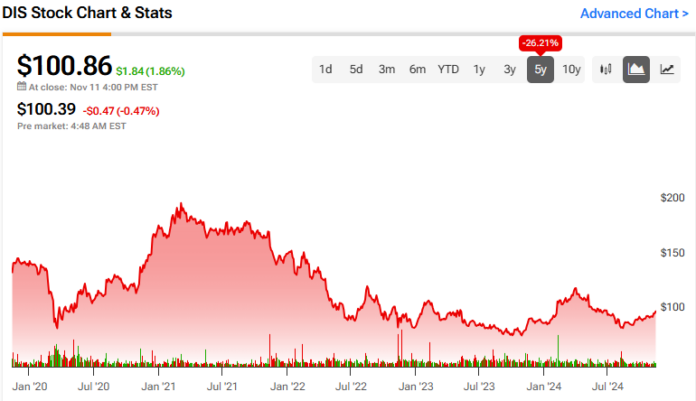Disney Faces Challenges but Streaming Growth Offers Hope Ahead of Q4 Earnings
The Walt Disney Company (DIS) is poised to announce its Fiscal Q4 earnings on November 14th. While the stock has fallen 26.21% over the past five years, the company’s improved valuations and promising streaming performance lead to a more optimistic outlook for Q4 and beyond. This comes in the context of continued struggles in its Parks & Entertainment segment, which is currently dealing with weaker consumer spending and various external pressures.

This article will analyze Disney’s performance this year, recap the last quarter’s results, and outline what investors should watch for in the upcoming earnings report that could lead to a more positive response for DIS stock.
Looking Back at Disney’s Recent Earnings
First, let’s recap Disney’s Fiscal Q3 earnings released in August. The California-based company reported earnings per share (EPS) of $1.39, beating analysts’ expectations of $1.19, with revenues reaching $23.2 billion, slightly above the projected $23.1 billion. Despite being about 20% lower than its all-time highs from April, the stock has rebounded nearly 15% since its lows in August.

Several complications have impacted Disney’s performance, especially within the Parks & Experiences segment, which historically has been a major contributor to profits. Last year, this segment achieved 70% of Disney’s segment profits, but it is expected to generate only about two-thirds this year. After anticipating a boost in operating income for Q2, the company’s growth expectations did not materialize in Q3.
During Q3, operating income from U.S. parks decreased by 6%, while international parks recorded a modest 2% growth. Disney linked the dip in domestic profits to inflation-related costs, increased spending on technology, and new guest offerings. The company foresees mid-single-digit profit declines in the Parks & Experiences segment for Q4, with difficulties likely to persist through the first three quarters of next year.
Optimism for Disney’s Streaming Sector
The optimism surrounding Disney largely revolves around its entertainment arm, particularly the moment when direct-to-consumer (DTC) profitability surpasses that of traditional linear networks.
Currently, linear networks are Disney’s largest profit source, albeit facing a gradual annual decline. For instance, operating income from these networks fell from $1.02 billion to $966 million. Conversely, the direct-to-consumer segment significantly improved, with losses declining from $505 million to just $19 million.
The narrative for Disney stock is expected to change rapidly once it crosses this crucial profitability benchmark. This shift will likely be aided by Disney’s bundling of services, price increases, reduced churn, and subscriber growth. Year-over-year direct-to-consumer revenue increased by 15%, already more than double that of linear networks.
Taking Netflix (NFLX) as a reference point shows the potential profitability in a streaming-first model. Notably, Disney’s direct-to-consumer streaming business, which includes ESPN+, reported a $47 million profit in Q3, exceeding previous guidance and marking its first ever profit. With this growth trajectory, analysts foresee that within five years, Disney could achieve hundreds of millions of dollars in quarterly profit, especially given its projected three-to-five-year EPS compound annual growth rate (CAGR) of around 13.3%.
Anticipations for Disney’s FQ4 Earnings
As Disney’s FQ4 earnings are set to be released on November 14 before the market opens, I maintain a positive outlook. I anticipate this quarter could record the highest growth rates in both earnings and revenue over the next nine quarters.
The consensus predicts EPS to be $1.10, indicating a significant 35% year-over-year increase. On the revenue side, analysts expect $22.49 billion, a 5.9% annual uptick. Interestingly, since the Fiscal Q3 results, 10 of 12 analysts have adjusted their EPS estimates downward, but 8 out of 12 have raised revenue forecasts.
Why Investors Might Buy DIS Stock Now
While I remain optimistic about Disney’s long-term outlook and see this as an advantageous time to purchase shares—especially with its current EV/EBITDA ratio of 13.5 times, roughly 50% below its five-year average—the stock’s immediate movement post-Fiscal Q4 results is tougher to predict. The company is still undergoing a transitional period as it aims to boost profitability in its direct-to-consumer business while mitigating challenges from lower consumer spending within Parks and Entertainment, which continue to generate a majority of revenue.
CEO Bob Iger’s return in 2022 refocused the company on producing higher-quality content for films rather than simply increasing the number of titles to meet budget targets. This strategy shift is vital after a prior approach that focused on lower-impact content, which hurt ratings and led to problematic financial outcomes. Therefore, if Disney demonstrates another strong quarter in its direct-to-consumer sector, it could signify significant long-term positivity.
Wall Street’s consensus reflects a Strong Buy rating for DIS, with 11 out of 14 analysts recommending a Buy and only three maintaining a Neutral rating. The average price target stands at $112.83, suggesting a potential upside of 11.87%.

See more DIS analyst ratings
Final Thoughts
Despite facing some immediate challenges within its Parks & Experiences sector, I remain optimistic about Disney’s potential. The company’s strong direct-to-consumer performance and commitment to high-quality content do well to position it for future growth. The upcoming earnings report is likely to showcase solid year-over-year growth in revenue and earnings, supporting my Buy rating based on its attractive valuation and positive momentum in streaming.
Disclosure
Disclaimer
The views and opinions expressed herein are the views and opinions of the author and do not necessarily reflect those of Nasdaq, Inc.

